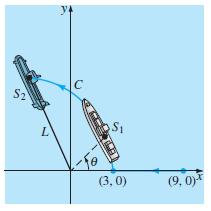In another naval exercise a destroyer S 1 pursues a submerged submarine S 2 . Suppose that
Question:
In another naval exercise a destroyer S1 pursues a submerged submarine S2. Suppose that S1 at (9, 0) on the x-axis detects S2 at (0, 0) and that S2 simultaneously detects S1. The captain of the destroyer S1 assumes that the submarine will take immediate evasive action and conjectures that its likely new course is the straight line indicated in Figure 5.3.9. When S1 is at (3, 0), it changes from its straight-line course toward the origin to a pursuit curve C. Assume that the speed of the destroyer is, at all times, a constant 30 mi/h and that the submarine’s speed is a constant 15 mi/h.
(a) Explain why the captain waits until S1 reaches (3, 0) before ordering a course change to C.
(b) Using polar coordinates, find an equation r = f (u) for the curve C.
(c) Let T denote the time, measured from the initial detection, at which the destroyer intercepts the submarine. Find an upper bound for T.
Figure 5.3.9.

Step by Step Answer:

A First Course in Differential Equations with Modeling Applications
ISBN: 978-1111827052
10th edition
Authors: Dennis G. Zill




